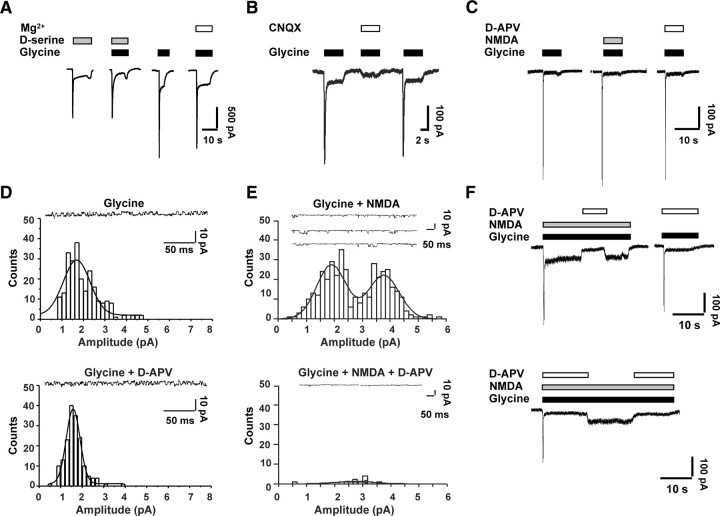Figure 2.
Patch-clamp recordings to show pharmacological properties of recombinant NR1/NR3 receptors expressed in HEK293 cells. A, d-Serine (200 μm) evoked currents in cells expressing recombinant NR1/NR3 receptors. Currents were observed even in the presence of 1 mm external Mg2+ (complete I/V relationship shown in supplemental Fig. 3B, available at www.jneurosci.org as supplemental material). B, CNQX (20 μm) inhibited the peak amplitude of glycine-evoked currents from NR1/NR3 receptors by ∼93%, with less prominent block (∼60%) of the steady-state response (n = 5). C, d-APV failed to inhibit glycine-evoked currents even at high micromolar concentrations (200 μm). D, Glycine (200 μm) evoked single-channel activity with a unitary conductance of 28.3 ± 1.3 pS (mean ± SEM; coapplication of 100 μm d-APV did not affect single-channel activity or conductance (26.7 ± 3.3 pS; n = 413 events from 7 patches). E, In NR1-, NR2-, and NR3-transfected HEK cells, 200 μm glycine plus 100 μm NMDA evoked single-channel activity with single-channel conductances of 32.0 ± 0.7 and 61.7 ± 0.7 pS (mean ± SEM, n = 401). Coapplication of 100 μm d-APV blocked virtually all single-channel activity (n = 4 patches). Gaussian functions were fitted to single-channel current amplitude distributions using a nonlinear regression method based on the Levenberg–Marquardt algorithm. Holding potential, −60 mV. F, NR1-, NR2-, and NR3-transfected HEK cells generated different populations of recombinant NMDAR subtypes. In whole-cell recordings, 100 μm d-APV blocked virtually all of the steady-state current evoked by 100 μm NMDA plus 200 μm glycine, consistent with the presence of NR2-containing receptors (either NR1/NR2 di-heteromeric receptors or NR1/NR2/NR3 tri-heteromeric receptors). In contrast, up to 200 μm d-APV only partially inhibited the peak current evoked by NMDA plus glycine, suggesting the presence of an additional population of NMDARs lacking NR2 subunits; since this second population underlying the initial peak current was activated by glycine alone in the presence of d-APV (top right panel), it most likely consisted of NR1/NR3 subunits. Holding potential, −60 mV in each panel.

